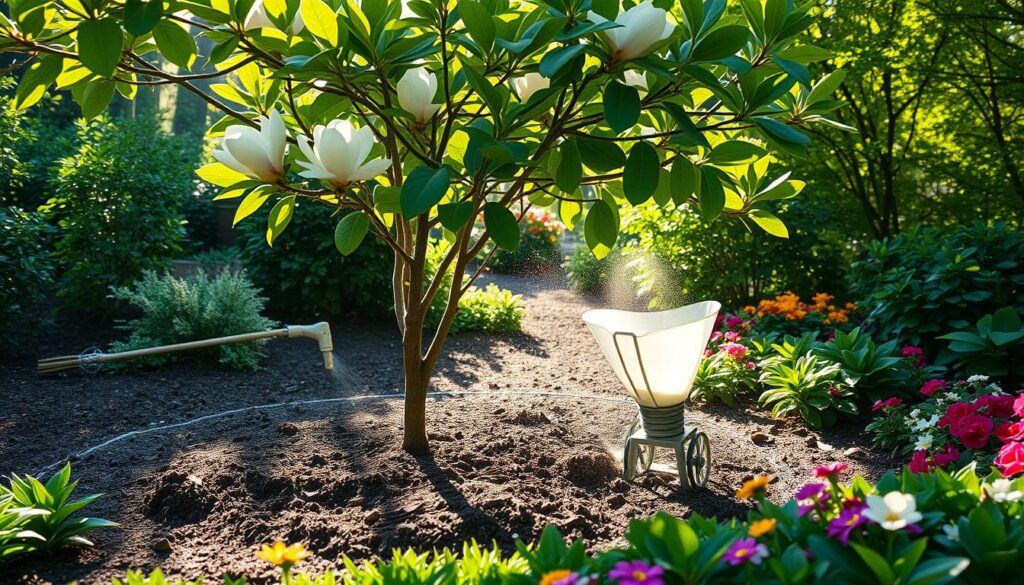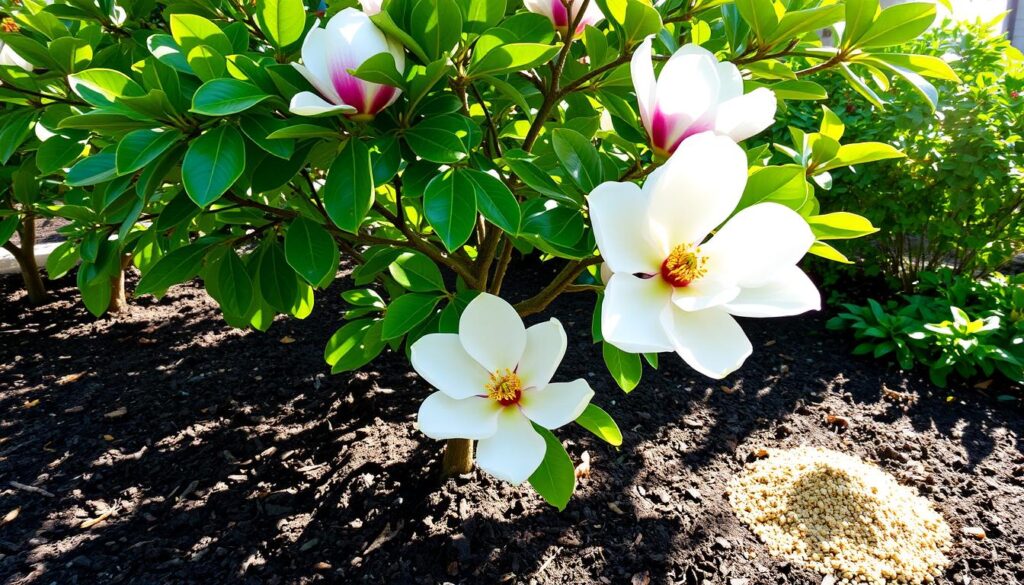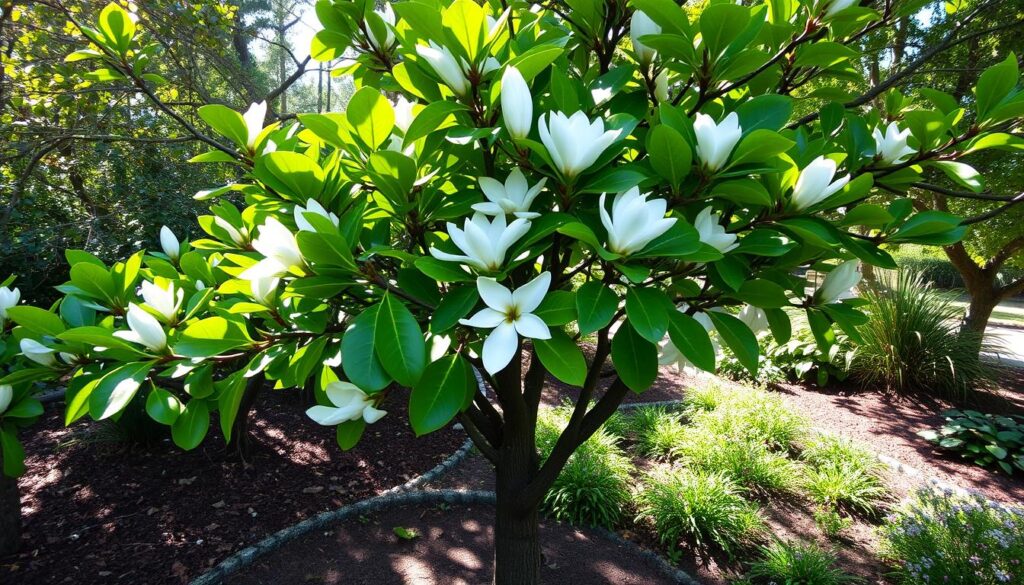Little Gem Magnolia trees are known for their stunning flowers and compact growth, reaching up to 20 feet tall. To promote healthy growth and flowering, it’s essential to use the right magnolia fertilizer. Fertilizer for little gem magnolia trees should be applied during the spring season. Recommended slow-release fertilizers include formulations such as 10-10-10 or 8-8-8.
Using the right fertilizer can make a significant difference in the health and appearance of your Little Gem Magnolia tree. With so many options available, it can be challenging to choose the ideal fertilizer. A good magnolia fertilizer can provide essential nutrients for your tree, promoting healthy growth and flowering.
When selecting a fertilizer for little gem magnolia trees, consider factors such as the tree’s age, size, and growing conditions. By choosing the right fertilizer and following proper application guidelines, you can help your Little Gem Magnolia tree thrive.
Table of Contents
Key Takeaways
- Choose a slow-release fertilizer for your Little Gem Magnolia tree, such as 10-10-10 or 8-8-8.
- Apply fertilizer during the spring season for optimal results.
- Consider the tree’s age, size, and growing conditions when selecting a fertilizer.
- Use a magnolia fertilizer that provides essential nutrients for healthy growth and flowering.
- Fertilizer for little gem magnolia trees can be applied in granular form under the tree, but application rates may be reduced when mulch is used.
- Regular fertilization can help promote healthy growth and flowering in your Little Gem Magnolia tree.
- Consult with a gardening expert or conduct further research to determine the best fertilizer for your specific tree and climate.
Understanding Little Gem Magnolia Trees
Little Gem magnolia trees grow up to 20 feet tall and have beautiful, fragrant flowers. They do well in well-drained soil and full sun to partial shade. To help these trees grow, it’s key to know their needs and how to care for them, including using the right fertilizer.
Characteristics of Little Gem Magnolia
Little Gem magnolias can grow in different soils as long as it’s well-drained. They are also deer-resistant, which is good for gardeners worried about wildlife. The leaves are 3 to 6 inches long, and the tree can handle cold but not below -10°F (-23.3°C).
Growth Habits and Conditions
These trees do best in USDA zones 7 to 10a. They need deep watering three times a week until they’re established. After that, watering can be once a week in summer. The recommended fertilizer is balanced, like 10-10-10 or 8-8-8, applied in Spring. The right fertilizer helps with growth and flowering.
Importance of Proper Care
Proper care is vital for Little Gem magnolias. This includes the right amount of water, fertilizer, and pruning to keep their shape. By understanding their needs and how to care for them, gardeners can create a perfect environment. This ensures the trees thrive with the right fertilizer and care.
Why Fertilizing is Essential
Fertilizing is key to keeping Little Gem magnolias healthy and strong. These trees need a balanced mix of nutrients to grow well. Without the right nutrients, they might get yellow leaves, grow fewer flowers, and be more vulnerable to pests and diseases. The right fertiliser for magnolia can greatly improve their health.
When picking the best fertilizer for magnolias, think about what the tree needs. A balanced fertilizer with an NPK ratio between 10-10-10 and 20-20-20 is best for magnolias. Regular feeding can help the tree grow better, bloom more, and fight off pests and diseases.
Nutrient Needs of Little Gem Magnolias
Little Gem magnolias need specific nutrients to grow well. The best NPK ratio for them is between 10-10-10 and 20-20-20. Regular soil tests help avoid nutrient imbalances and make sure the tree gets what it needs.
Effects of Nutrient Deficiency
Nutrient deficiency can harm Little Gem magnolias a lot. Some common problems include:
- Yellowing leaves
- Reduced flowering
- Increased susceptibility to pests and diseases
Benefits of Regular Fertilization
Regular fertilization brings many benefits to Little Gem magnolias, such as:
- Enhanced growth
- Improved flowering
- Increased resistance to pests and diseases
Best Fertilizers for Little Gem Magnolia Trees
Choosing the right fertilizer for Little Gem magnolia trees is key. Look for a balanced fertilizer with an NPK ratio of 10-10-10 or 14-14-14. Organic fertilizers like compost or well-rotted manure also help with growth.
For Little Gem magnolia trees, a magnolia bush fertilizer or a fertilizer for little gem magnolia trees is best. Make sure it’s made for acid-loving plants like magnolias.
Some good choices include:
- Slow-release fertilizers, which give nutrients over time
- Organic fertilizers, which help soil health
- Acid-forming fertilizers, which keep soil pH right
Choosing the right fertilizer for little gem magnolia trees ensures your tree gets what it needs. Always follow the instructions and consider your tree’s specific needs and environment.
| Fertilizer Type | NPK Ratio | Benefits |
|---|---|---|
| Slow-release | 10-10-10 | Promotes healthy growth, reduces soil pollution |
| Organic | Varies | Improves soil biota, structure, and overall health |
| Acid-forming | 14-14-14 | Maintains optimal soil pH, promotes nutrient uptake |
How to Apply Fertilizer
Timing is key when fertilizing your Little Gem Magnolia tree. The best time is in early spring, as per the best fertilizer for magnolia trees instructions. It’s vital to avoid over-fertilizing, which can harm the tree. Use a slow-release balanced fertilizer with a 10-10-10 or 8-8-8 formula.
To fertilize, first read the label and follow the instructions. Aim to use 1-2 pounds of fertilizer for every 100 square feet of soil. You can also opt for a magnolia fertilizer made for these trees. Water the tree well after applying to help it soak up the nutrients.

- Apply fertilizer in the early spring, when the tree is actively growing.
- Follow the manufacturer’s instructions for the recommended amount of fertilizer to apply.
- Water the tree thoroughly after applying the fertilizer.
- Avoid over-fertilizing, which can damage the tree.
By following these tips and using the right best fertilizer for magnolia trees, your Little Gem Magnolia tree will thrive. It will enjoy beautiful blooms for many years.
| Fertilizer Type | Application Rate | Timing |
|---|---|---|
| Slow-release balanced fertilizer | 1-2 pounds per 100 square feet | Early spring |
| Magnolia fertilizer | Follow manufacturer’s instructions | Early spring |
Frequency of Fertilization
Fertilizing Little Gem magnolia trees at the right time is key. It’s best to fertilize every 6-8 weeks when they’re growing. Young trees might need more food to grow fast. This helps them grow twice as fast.
Change how often you fertilize based on the tree’s age. For new small magnolias, use 1 teaspoon of fertilizer for little gem magnolia trees every month from March to August. As the tree gets bigger, you can adjust how often and how much you fertilize. A magnolia tree fertilizer with a balanced mix, like 8-8-8 or 10-10-10, is best.
Too much fertilizer can harm your tree. It might turn yellow, get scorched, or stop flowering. Watch how your tree reacts and adjust when needed. A balanced fertilization plan helps your tree grow well and bloom beautifully.
Spring vs. Fall Fertilization
Spring and early summer are the best times to feed your tree. But, fertilizing in fall also helps. It gets your tree ready for the next growing season. The right magnolia tree fertilizer and timing ensure your tree gets the nutrients it needs.
Understanding Soil Health
Soil health is key for Little Gem Magnolia trees to grow well. They need well-drained, slightly acidic soil with organic matter. The pH should be between 5.5 and 6.5. A balanced slow-release fertilizer is great for keeping the soil healthy.
To find the right fertilizer, test the soil often. A soil test shows the pH, nutrient levels, and more. This info helps gardeners pick the best fertilizer for their trees.

- Soil pH level: Little Gem Magnolia trees prefer a slightly acidic to neutral soil pH, ranging from 5.5 to 6.5.
- Soil texture: A well-drained soil with a mix of organic matter is essential for healthy root growth.
- Soil structure: A balanced soil structure with adequate aeration and water retention is critical for optimal tree growth.
By keeping the soil healthy, gardeners can help their Little Gem Magnolia trees thrive. The right fertilizer and care practices are key.
| Soil Factor | Optimal Range | Importance |
|---|---|---|
| Soil pH | 5.5-6.5 | Crucial for nutrient uptake and tree growth |
| Soil Texture | Well-drained with organic matter | Essential for healthy root growth and water retention |
| Soil Structure | Balanced with adequate aeration and water retention | Crucial for optimal tree growth and development |
Additional Nutrients to Consider
When it comes to fertilizing Little Gem magnolia trees, a magnolia fertilizer is key. It gives them the nutrients they need to grow well. But, there are other nutrients that can help too, like iron, zinc, and manganese.
These micronutrients are vital for the tree’s health. They can be found in fertilizer for little gem magnolia trees that includes them. Compost and mulch also help by adding nutrients and improving the soil.
Micronutrients for Healthier Growth
Micronutrients are important for Little Gem magnolia trees to grow strong. Key nutrients include:
- Iron: essential for making chlorophyll
- Zinc: important for plant growth and development
- Manganese: helps enzymes work and promotes growth
Benefits of Compost
Compost is great for Little Gem magnolia trees. It offers:
- Improved soil structure
- More nutrients
- Better microbial activity
Using Mulch as a Supplement
Mulch helps Little Gem magnolia trees get more nutrients. It also keeps the soil moist and stops weeds. Mulch benefits include:
- Healthier soil
- More nutrients available
- Looks better
Watering Tips Post-Fertilization
After using the best fertilizer for magnolia trees, it’s key to water them right. The fertilizer gives them the nutrients they need. But, too much water can harm the roots and wash away nutrients. So, water your magnolia tree deeply but not too often, letting the soil dry a bit between waterings.
It’s good to give your tree at least 1 inch of water each week. This can come from rain or your watering can. But, how often you need to water depends on your soil and weather. For example, if it rains a lot, you might not need to water as much. But if it’s dry, you’ll need to water more.
Proper Watering Techniques
- Water your magnolia tree at the base of the trunk, avoiding the leaves and flowers to prevent fungal diseases.
- Use a soaker hose or drip irrigation system to deliver water directly to the roots, reducing evaporation and runoff.
- Avoid getting water on the trunk or leaves to prevent disease and pest issues.
By following these watering tips and using the best fertilizer for magnolia trees, you can help your tree thrive. Enjoy its beautiful blooms for years to come. Keep an eye on how your tree reacts to the fertilizer and adjust your watering as needed for the best results.
Troubleshooting Common Issues
Little Gem Magnolia trees can face problems like yellow leaves, pests, and diseases. Keeping an eye on them and acting fast can solve these issues. For example, yellow leaves might mean the tree needs more nutrients. Using a balanced magnolia fertilizer can help.
It’s key to pick the right fertilizer for little gem magnolia trees. This ensures they grow well and stay healthy.
Some common issues with Little Gem Magnolias include:
- Overwatering, which can cause root rot and yellow leaves
- Pests like aphids, scale insects, and spider mites can harm the tree
- Diseases such as powdery mildew and rust can affect the tree’s health
Knowing these problems and acting early can help your trees do well. Regular use of a balanced magnolia fertilizer promotes growth. Also, the right fertilizer for little gem magnolia trees is vital for their health.
Environmental Factors Affecting Growth
Several environmental factors impact the growth of Little Gem Magnolia. The best fertilizer for magnolias is important, but so is sunlight, water, and nutrients. Little Gem Magnolias need at least six hours of direct sunlight daily. This makes them perfect for sunny gardens.
They also prefer well-drained, slightly acidic soil. A pH range that’s right for the fertiliser for magnolia is key. Regular watering is vital, with deep waterings once a week. Adding a 2-3 inch layer of mulch helps keep the soil moist and at a good temperature.

Knowing these environmental factors helps gardeners care for their trees better. With the right conditions, including the best fertilizer, Little Gem Magnolias will bloom beautifully for years.
Important care tips for Little Gem Magnolias include:
- Sunlight: at least six hours of direct sunlight daily
- Watering: deep waterings once a week
- Soil: well-drained and slightly acidic
- Mulching: 2-3 inch layer around the base of the tree
By considering these factors and using the right fertiliser for magnolia, gardeners can help their Little Gem Magnolia thrive. They’ll enjoy its stunning blooms for many years.
Local Fertilizer Application Strategies
Fertilizing Little Gem magnolia trees requires knowing the local conditions. Using regional resources and getting advice from local experts is key. For example, soil type and climate affect how well fertilizers work. So, it’s important to pick a fertilizer that fits your tree’s needs based on your area’s soil and weather.
Choosing the right fertilizer for your Little Gem magnolia depends on its specific needs. This includes the local soil and climate. By adjusting to these conditions, you can make sure your tree gets the nutrients it needs to grow well. Important things to think about include:
- Soil pH, which should be between 5.5 and 7.0 for Little Gem magnolias
- Climate, which can affect the frequency and type of fertilization needed
- Regional resources, such as local nurseries or gardening experts, which can provide valuable guidance on fertilization strategies
By considering these factors and getting advice from local experts, you can create a fertilization plan. This plan will meet your Little Gem magnolia tree’s unique needs. It will help your tree grow strong and bloom beautifully.
Season-Specific Care for Little Gem Magnolias
As the seasons change, so do the needs of your Little Gem Magnolia. By focusing on each season, your tree will grow and bloom better all year.
Spring Preparation and Fertilization
In early spring, get your magnolia ready for growth. Use a balanced fertilizer like 10-10-10 or 8-8-8. This gives your tree the nutrients it needs for strong growth and beautiful flowers in summer.
Summer Growth Tips
When it gets hot, watch how much water your tree needs. Water deeply to keep the roots healthy and prevent leaves from turning yellow or wilted. Prune only to remove dead or damaged branches, helping your tree grow well.
Winter Maintenance Practices
In winter, your magnolia needs a different care plan. Don’t prune too much, as it can harm the tree. Instead, mulch around the base to keep roots warm and moist. Also, check for pests or diseases to help your tree start strong next spring.
Frequently Asked Questions
What is the best fertilizer for Little Gem Magnolias?
Use a slow-release, balanced fertilizer designed for trees or flowering plants. Look for something with:
Nitrogen (N) – Promotes green leafy growth
Phosphorus (P) – Encourages strong root development
Potassium (K) – Helps with overall health and blooming
A 10-10-10 or 8-2-12 with added magnesium works well. Apply in early spring and mid-summer for best results.
How to thicken up a Little Gem Magnolia?
If your tree looks thin or sparse, try these steps:
Prune lightly in late winter to encourage branching. Cut just above a bud or side branch.
Fertilize regularly to support strong growth.
Water consistently but don’t overdo it—Little Gems need moist, well-drained soil.
Ensure full sun—at least 6 hours a day helps produce dense foliage.
How to care for a Little Gem Magnolia?
Water deeply (1-2 times per week, more in hot weather)
Mulch around the base to retain moisture and protect roots
Fertilize in spring and summer with a slow-release tree fertilizer
Prune only as needed to remove dead or weak branches
Provide full sun to partial shade for best growth
How do you make Magnolia Little Gem grow faster?
Keep the soil moist but not soggy—consistent watering helps young trees establish faster.
Use a balanced, slow-release fertilizer in early spring and summer.
Make sure it’s getting full sun (at least 6 hours daily).
Mulch around the base to keep the soil cool and moist.
Avoid heavy pruning—cutting too much can slow growth.
When should Magnolia trees be fertilized?
Magnolias should be fertilized in early spring (March-April) and again in mid-summer (June-July). Avoid fertilizing in late fall, as it can encourage new growth that might get damaged in winter.
Why is my Little Gem Magnolia not blooming?
If your Little Gem isn’t blooming, check these possible reasons:
Too young – It can take a few years for a young tree to start blooming.
Not enough sun – Needs at least 6 hours of direct sunlight daily.
Too much nitrogen – Excessive fertilizer (especially high in nitrogen) can lead to lots of leaves but few flowers.
Improper pruning – Cutting off buds in late summer or fall can remove next season’s flowers.
Water stress – Either too much or too little water can prevent blooming.

